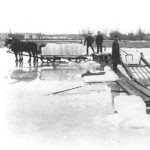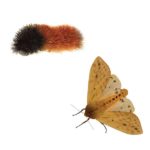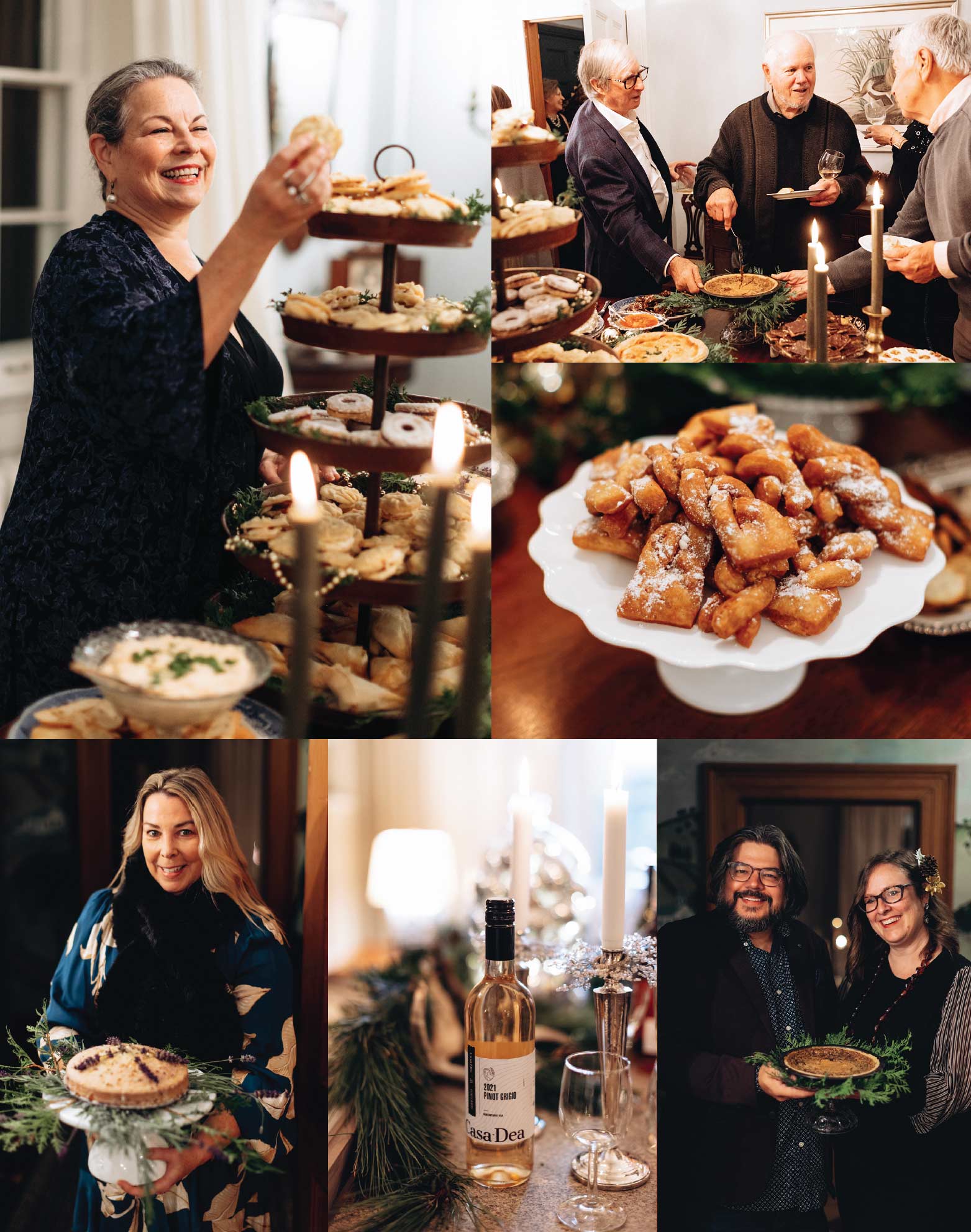
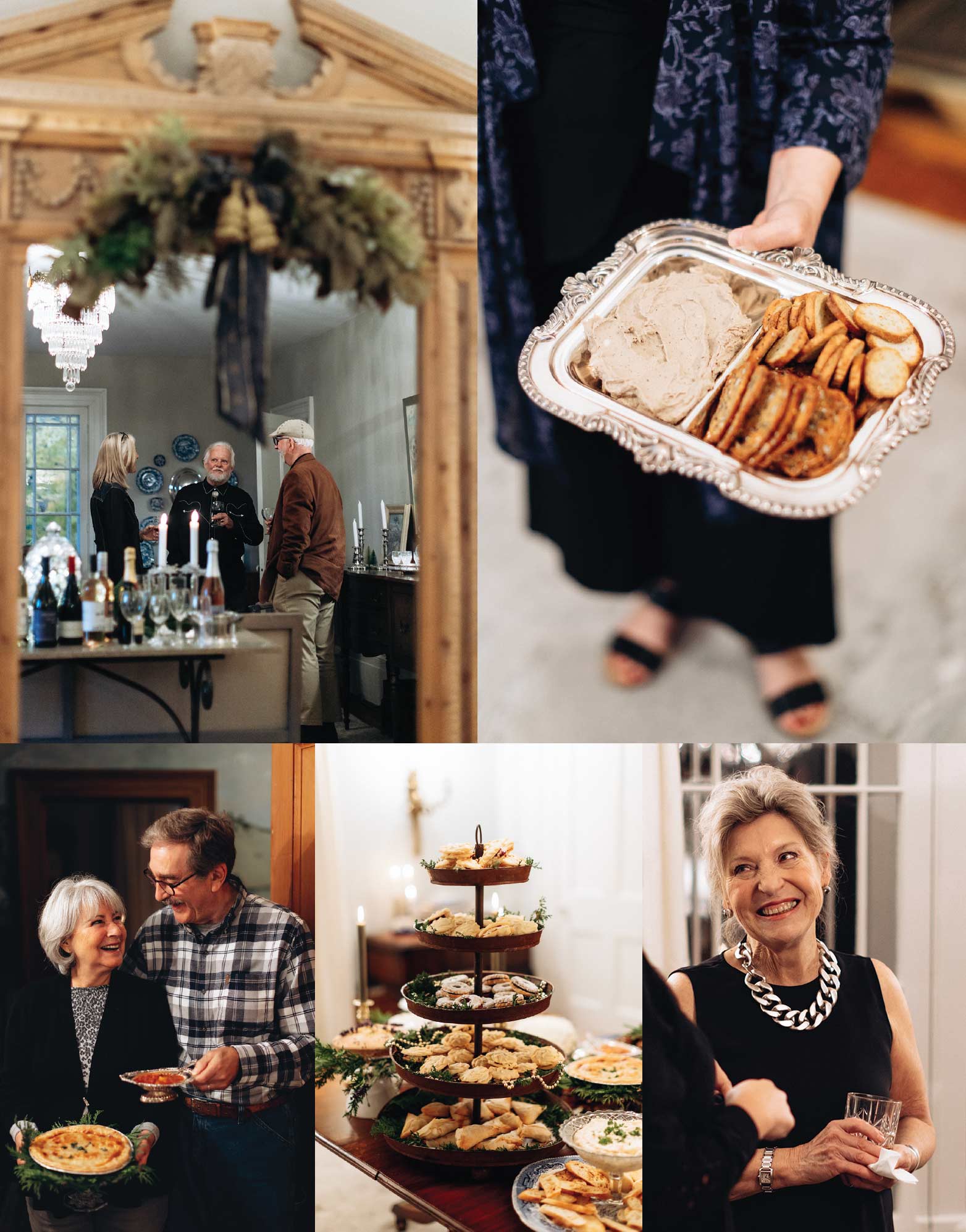
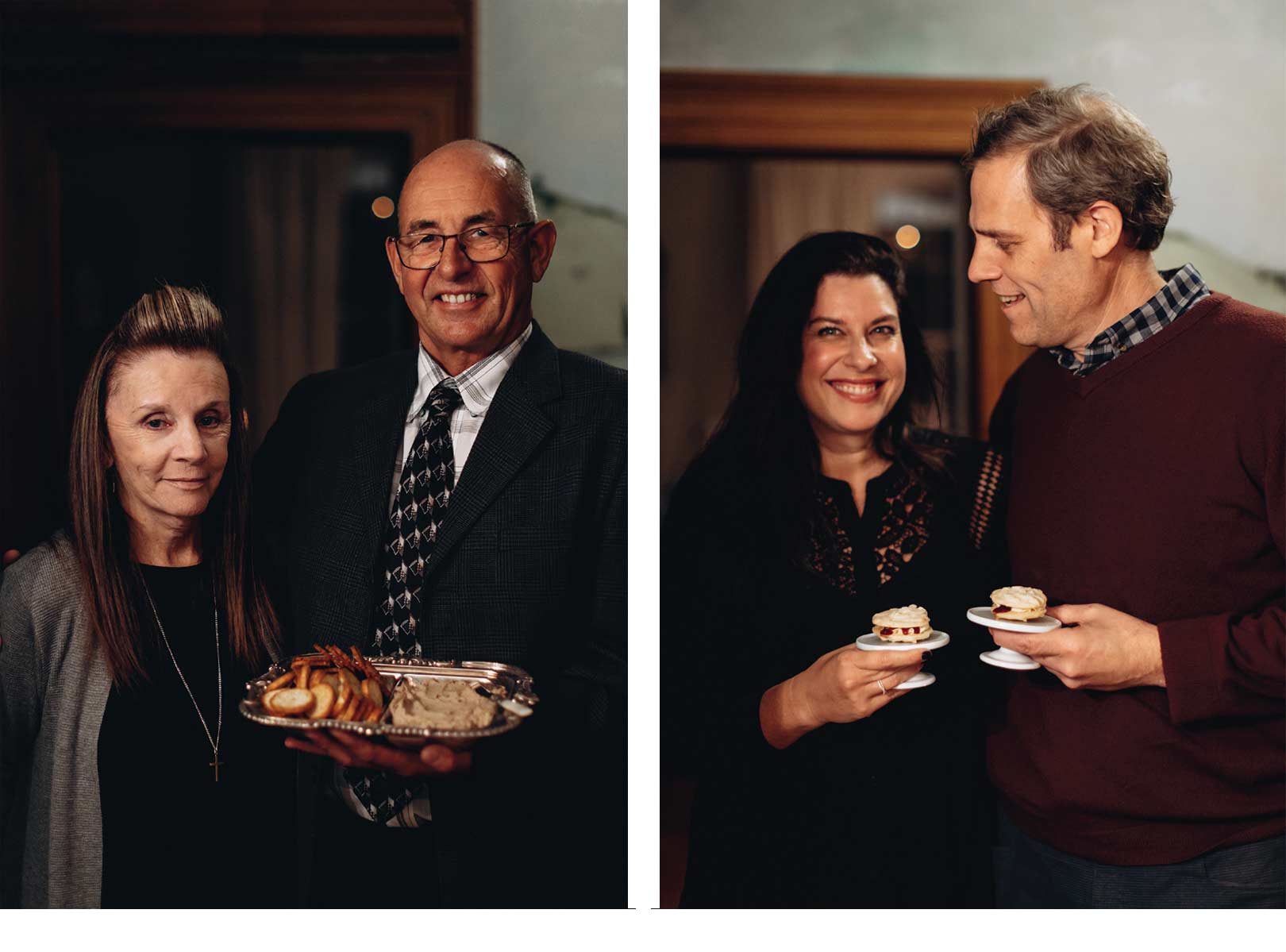
Watershed publisher Jane Kelly reinvents the holiday office party, and it was so much fun, we know you’ll want to do it with your friends and family, too.
It’s been said that life should be a celebration, not a competition. How about a little of both? On a crisp night, Watershed staff and plus ones gathered for a joyful and delicious feast at publisher Jane Kelly’s Grafton home. Candles flickered, holiday gold and silver glittered, and boughs of evergreen brought the outside in, reminding us that spring will return.
In the dining room, the food was piling up. Jane had asked everyone to bring a holiday dish, and boy, did they oblige. Cakes and cookies; tarts and rolls, triangles and spirals, each with a story, a tasty side of history or family lore. And while eating and sharing is fine, adding the element of competition makes things a little spicier. Especially when there are prizes and major bragging rights up for grabs.
A supply of Pepto in my purse, I got down to the task of tasting each dish and judging them on presentation, taste, and originality. The table was loaded, but I’m nothing if not a consummate professional – and just about always hungry – so I persevered until all 15 dishes had been sampled. Sometimes twice. Okay, sometimes three times. I’m not proud of it, but it had to be done. Like I said, a consummate professional – with antacids.
To characterize the Watershed crew as, well, idiosyncratic – eccentric, even – would not be putting too fine a point on it. We are exactly what one would expect from an eclectic and diverse group of creatives.
Albert Botha, husband to Meg Botha, Watershed’s Art Director, went back to his South African roots with a plate of sugar dusted koeksister. Just about every cuisine has a decadent fried dough recipe, and Afrikaners are no exception. Brought to South Africa by Dutch colonists in the early 1600s, the koeksister is a braid of dough, deep fried, then soaked in syrup. Oh, they were good, but the winner was still to be found.
Another sweet contender was illustrator Charles Bongers’s lushly frosted carrot cake, a recipe handed down through many generations, each one adding their personal touch. “Granny added the walnuts,” says Bongers. “Mom added the cinnamon, and I added the coconut.”
Tom Groot, one of Watershed’s proofreaders, brought his holiday showstopper; a chocolate-inside, white and fluffy outside, snowball cake. Yes, it was good, and good-looking, Christmas-y, and most importantly, it was ravaged – nothing but a few crumbs left behind – but I was still looking for my Number One. While everything on the table was tasty and festive – elegant crab dip; traditional tourtière; a gorgeous citrus lavender cake; Québécoise tarte au sucre d’érable from illustrator Luke Despatie’s grandmère – there could only be one sweet, and one savoury winner.
As wine flowed, pretty little hors d’oeuvres were passed, and a Watershed team-curated playlist supplied a beat in the rest of the house, I was as busy as a squirrel preparing for winter in the dining room, tasting, scoring out of five, and being rather too judgmental for the season. Still, I had a job to do. So, when Field Notes writer, Roger Thomas, presented me with his dish of squirrel liver pâté, I did not flinch. I dug right in, and colour me nutty, it was delicious. Rich and smooth, sharp and a little gamy, it was my savoury winner. And while I’m inclined to befriend the squirrels in my garden, squirrel is a noble wild food; small game that folks have hunted and eaten forever. A few years back, Quebec chef and enfant terrible, Martin Picard, included a recipe for squirrel in his Au Pied de Cochon cookbook, and my dog-eared copy of The Joy of Cooking has recipes for squirrel too, so Roger is in good company, although he did raise a few eyebrows and sent a guest or two scampering in the other direction.
“I was raised in the wilds of the Rainy River District, a five-hour drive west of Thunder Bay,” recalls Roger. “We ate wild game harvested by our father, who was a school teacher in a one-room wilderness school in an unincorporated township void of any utilities, including electricity. He was a logger and trapper out of pure necessity – we were poor folk – wild duck, prairie chicken, ruffed and spruce grouse, geese, bear, moose, deer, and fish were standard table fare. Some were eaten fresh, and then Mom canned the surplus as we had no freezer. Years later when I moved to Northumberland, my neighbour, Bob Homme, the Friendly Giant, and his wife Esther, always asked me for duck livers to make pâté. I obliged them with a generous supply and she would supply me with some pâté. It was delicious, and when the Watershed challenge arose, I wanted to replicate the duck liver pâté but had no duck liver; so, with an abundance of squirrels on my property, I shot five, cleaned them, took their livers and, trimmed out the loins to use. I reviewed several pâté recipes and from them, developed my own, replacing the called-for meat with squirrel loins and livers.”
Roger’s pâté isn’t flashy or overly fancy, it’s just really good. Often the finest foods are the most humble and unassuming. Just like the demure, white sandwich cookie delivered by Mark Dyett, husband of Watershed’s Life au Lait columnist, Lonelle Selbo. One bite of this sandwich cookie took it straight to the top of my list, and it had some pretty stiff competition. The biscuits were beyond melt-in-the-mouth: the buttercream filling, rich and creamy without being cloyingly sweet, while the dollop of homemade strawberry jam cut right through the butterfat. Perfection. I may have taste-tested this one more than was strictly necessary.
Mark hails from London, UK, but his West Country Swirls are an ode to his ancestral homeland, Dorset, a part of England renowned for its dairy products. “I experimented with varying cooking times, cooling and racking protocols, and different fillings, ending up with a creamy buttercream centre circled around a lightly spiced homemade strawberry jam,” says Mark. “The jam was developed in conjunction with our dear friends at the Snip Family Farm in Cherry Valley; it has the perfect fruit-to-spice balance.” The spice? Mark added just a hint of cardamom to the jam.
Both the cookie and pâté delivered what we hope to deliver with every issue we publish: flavour, personality, and most of all, a heartfelt story.
Roger’s Squirrel Pâté
In Ontario, as long as you have the appropriate licence, it’s perfectly legal to hunt squirrel September through December. But let’s just say you’re not up for a little squirrel hunting; chicken or duck livers from the butcher will do just fine. But if you plan on going full Grizzly Adams, remember to gently remove the gall bladder from the squirrel livers and soak them overnight in milk.
Ingredients
½ cup unsalted butter
5 livers, squirrel, chicken or duck
½ lb. deboned squirrel meat or chicken cut into thin strips
1 large red onion, diced
3 cloves garlic, minced
½ cup 35% cream
4 oz. cream cheese
1 tbsp. finely chopped fresh sage leaves
1 tsp. finely chopped fresh rosemary; stem discarded
½ tsp. finely chopped fresh thyme; stem discarded
2 hard-boiled free-range eggs
½ tsp. fine sea salt
Pinch pepper or more to taste
Directions
- Into a large skillet over medium heat, add butter, onion, and squirrel meat; stir and cook for about 2 minutes or until the meat has browned some, then add the prepared and drained livers.
- Continue to cook and stir for 4 minutes or until meat is cooked all the way through.
- Add garlic, stir and cook for 1 minute. Transfer contents of skillet to the bowl of a food processor. Add cream and purée for about 30 seconds; add cream cheese, herbs, eggs, salt and pepper and continue to purée until smooth, adding a dash more cream if needed.
- Pack into a jar or bowl for serving; allow to cool completely before chilling in the fridge. Serve chilled.
Makes about 2 cups.
Mark’s West Country Whirls
“These delicate butter cookies are a take on the Viennese Whirls I remember fondly from my youth when my granny would make a homemade version of the boxed cookie made by the veritable Mr. Kipling. My granny had magic baking hands, and would often be seen sporting a flour-covered apron. She never measured anything, knowing exactly how much of everything she needed.” We aren’t all as talented as Granny, so, break out the kitchen scale; for the best results when baking use weights not volumes for dry ingredients.
Ingredients
25 grams of cornstarch
225 grams cake flour
250 grams soft but not oily butter
50 grams icing sugar, twice sifted
For the Buttercream Filling
100 grams soft but not oily butter
200 grams icing sugar, twice sifted
½ tsp. vanilla extract
½ cup strawberry jam, or another favourite jam; homemade is always best
Directions
- Preheat oven to 350°F.
- Line a cookie sheet or two with parchment paper; set aside.
- Prepare a piping bag with a star tip; set aside.
- Into a small bowl sift the cornstarch into the flour; set aside.
- In a large bowl, using a handheld or stand mixer on medium speed, beat butter and sugar together until creamy.
- Continuing to beat, gradually add the flour/cornstarch mix until a soft creamy batter forms. Transfer into piping bag and pipe in circular spirals onto the prepared cookie sheets, piping from the outside, spiralling inwards, ending in a tiny peak at the centre.
- Bake for 11 minutes, then open oven door for a second to let some heat escape; close it again, and turn off heat. Watch closely; cookies should be pale with only the slightest hint of colour at the edges. Remove from oven; allow to cool for 5–10 minutes on the tray before transferring carefully to wire cooling racks. Once fully cooled, transfer back onto a tray and into the fridge to firm up before assembly.
- While cookies are cooling, make the filling. In a large bowl with handheld or stand mixer on medium speed, cream together butter, sugar and vanilla until soft and fluffy; this may take several minutes.
- To assemble the cookies, set the swirls out, bottoms up, in pairs.
- Fill piping bag with buttercream, pipe a generous swirl of the buttercream onto one half of the cookie pair, then place a 1/4 teaspoon of jam in the middle. “Too much jam and you’ll have a sticky mess,” warns Mark. “Too little and your friends will miss out on that ‘ooh’ moment.” Top with the second cookie and lightly press together.
- Refrigerate for storage but be sure to serve at room temperature.
Makes about 15 assembled cookies.
Story by:
Signe Langford
Photography by:
Mira Knott

